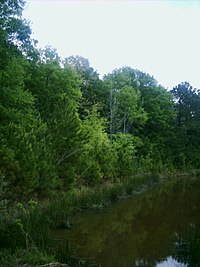Piney Woods

The Piney Woods is a terrestrial ecoregion in the Southern United States covering 54,400 mi² (140,900 km²) of East Texas, Southern Arkansas, Western Louisiana, and Southeastern Oklahoma. This coniferous forest, is dominated by several species of pine, including Longleaf Pine, Shortleaf Pine and Loblolly Pine, as well as several varieties of hardwoods including Hickory and Oak. The World Wide Fund for Nature considers the Piney Woods to be one of the critically endangered ecoregions of the United States.[1]
Flora and fauna
Flora
The region has heavy to moderate rainfall, with some places receiving over 60 in (1525 mm) of rain per year. Many deciduous trees such as Magnolia, Sweet gum, Tupelo, and Yaupon Holly, in addition to hickories and oaks, can be found among pines. Wisteria is also common place and can cover entire groves of trees in the wild. Flowering species of tree, such as Dogwood and the Eastern Redbud are also now common in the wild.

Two varieties of wetlands are common in the Piney Woods: bayous are generally found near rivers and sloughs which are generally found near creeks. In bayous Bald cypress and Spanish moss, as well as the non-native Lily pad, are common plants. Sloughs are shallow pools of standing water that most trees are capable of growing in. Though some species such as the Purple bladderwort, a small carnivorous plant, have found a niche in sloughs.
Hearty species of Prickley pear cactus and Yucca can be found both in the forests and wetlands.
The indigenous Texas trailing phlox is an endangered species.
Fauna
Mammals such as Eastern Cottontail rabbits, Eastern Gray Squirrels, Opossums, White-tailed Deer, and two species of Bats; and Reptiles such as Cottonmouth Water Moccasins, Prairie Kingsnakes, Slender glass lizards, and Squirrel Tree Frogs, thrive in the Piney Woods. A large variety of birds from Cranes and Vultures to individual species like the Mockingbird and the endangered Red-cockaded woodpecker. Alligators are not as common as they once were, but their population has rebounded since the 1960s. Bears are rare today, but still live in remote thickets. Recently, there has been significant talk of reintroducing the black bear into many parts of East Texas.[2][3] The most common fish is Catfish, which are a native species but also stocked in local reservoirs. A small crustacean called the crayfish (commonly called "crawfish" or "crawdad" in the local vernacular) is common along river and creek banks.
Piney Woods of East Texas

The majority of the commercial timber growing and wood processing in the state of Texas takes place in the Piney Woods region, which contains about 50,000 km² (12.5 million acres) of commercial forestland.
This area includes at least 17 state parks: Atlanta State Park, Caddoan Mounds State Historic Site, Caddo Lake State Park, Daingerfield State Park, Governor Hogg Shrine Historic Site (Quitman), Huntsville State Park, Jim Hogg Historic Site (Rusk), Lake Bob Sandlin State Park, Lake Livingston State Park, Martin Creek Lake State Park, Martin Dies Jr. State Park (Jasper), Mission Tejas State Park, Rusk and Palestine State Parks, Starr Family State Historic Site, Texas State Railroad State Park, Tyler State Park, and Village Creek State Park. Four National Forests - Angelina (Angelina County, Nacogdoches County, San Augustine County and Jasper County), Sabine, Davy Crockett, and Sam Houston (Huntsville)- are found in the "Piney Woods" of East Texas. These National Forests include some 634,912 acres (2,569 km²) in 12 counties.
Reference
- ^ World Wildlife Fund Scientific Report on Piney Woods forests (NA0523)
- ^ WHERE THEY ONCE ROAMED / Will bears prowl Piney Woods?. Houston Chronicle. July 6, 2005.
- ^ Push grows to make E. Texas bear country. Houston Chronicle. August 8, 2006.
